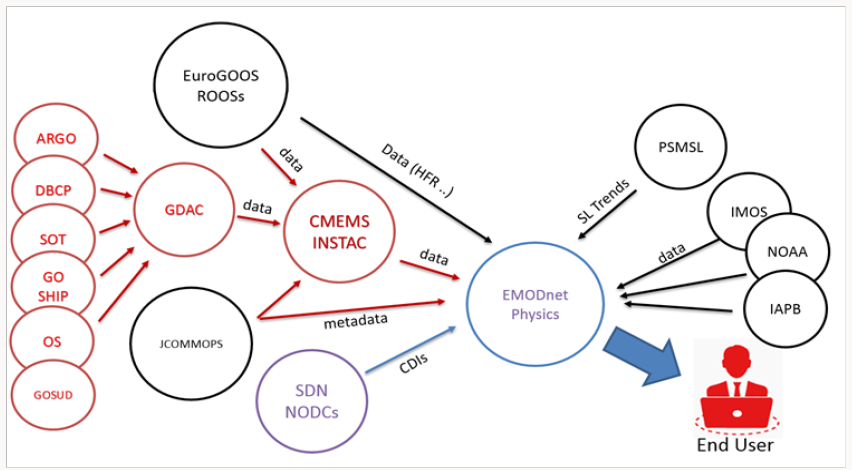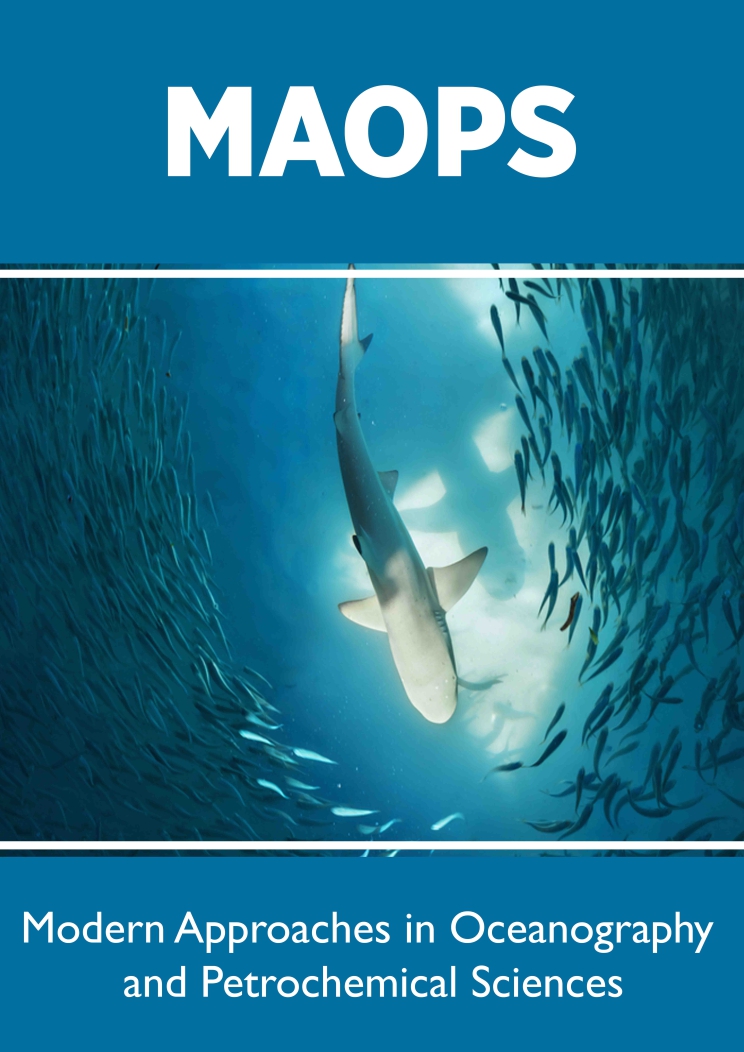
Lupine Publishers Group
Lupine Publishers
Menu
ISSN: 2637-6652
Research Article(ISSN: 2637-6652) 
Emodnet Physics: Benefits from Marine Data Sharing Volume 1 - Issue 5
Giuseppe MR Manzella*, Antonio Novellino and Paolo D Angelo
- Institute of Soil Science and Agro chemistry of ANAS Az 1073, Baku str, Azerbaijan
Received: May 22, 2018; Published: May 29, 2018
Corresponding author: Giuseppe MR Manzella, ETT SpA
DOI: 10.32474/MAOPS.2018.01.000124
Abstract
Access to marine data is of vital importance for marine research and a key issue for various studies, from climate change prediction to off shore engineering. Giving access to and harmonising marine data from different sources will help industry, public authorities and researchers find the data and make more effective use of them to develop new products, services and improve our understanding of how the seas behave. The European Marine Observation and Data Network (EMODnet) is a long term program to deliver a marine observation infrastructure that offers the most effective support to the marine and maritime economy whilst supporting environmental protection needs. The paper is presenting the activities achieved by the EMODnet Physics. EMODnet Physics provides a combined array of services and functionalities (facility for viewing and downloading, dashboard reporting and machine-to-machine communication services) to obtain, free of charge data, meta-data and data products on the physical conditions of European sea basins and oceans. Moreover, the system provides full interoperability with third-party software through WMS services, Web Services and Web catalogues in order to exchange data and products according to the most recent standards.
Keywords: Marine Data Management; Data Portal; Data Services; Interoperability
Abbrevations: CF: Climate and Forecast; IAPB: International Arctic Buoy Programme; IMOS: Integrated Marine Observing System; NOAA: National Oceanic and Atmospheric Administration; NetCDF: Network Common Data Form; SOAP: Simple Object Access Protocol; WFS: Web Feature Service; WMS: Web Map Service.
Introduction
There are many efforts undergoing to allow a free and open access to marine data and their re-use. If successful and well organized, these efforts will have some benefits for society, research, and business. They could improve the extent, completeness and ease of access to marine data required by industries and agencies supplying products to industry and citizens directly. Portals providing free and open access to marine data could support (e.g.) sea culture, fishery, operational weather forecast for offshore energy and mining, water quality prediction, marine food safety. The improvement in quality and access to data will reduce costs and delays in existing industries and promote the development of emerging markets and practices (e.g. seabed mining, offshore aquaculture). Research can implement sampling strategy and coverage by systematically filling observational gaps for specific under sampled areas, close the gap between continental shelf and deep ocean observing networks and closing the gap between near real time observation delivery and its high-level qualification and long-term preservation. The European Commission, represented by the Directorate General for Maritime Affairs and Fisheries (DG MARE), is working on services for assembling marine data, metadata and data products and facilitating their access and re-use. In particular, the European Marine Observation and Data Network (EMODnet) is a long-term program to deliver a marine observation infrastructure that offers the most effective support to the marine and maritime economy whilst supporting environmental protection needs (Calewaert et al., 2016). Within the EMODnet programme, the Physics Portal provides access to near real-time data and historical time series datasets on the physical conditions of European seas and oceans and to determine how well the data meets the needs of users from industry, public authorities and scientists. Fulfilling the tender requirements, the portal is providing the following types of measurements:
a) Wave height and period
b) Temperature and salinity of the water column
c) Wind speed and direction
d) Horizontal velocity of water column
e) Optical property (light attenuation)
f) Sea-level
g) River runoff
h) Underwater noise
Furthermore, the portal is providing information on river runoff trends, sea ice coverage and total suspended matter for selected areas.
Figure 1: EMODnet Physics data stream. ROOS: Regional Oceanographic Operational System; NODC: National Oceanographic Data Centre; CMEMS: Copernicus Marine Environment Monitoring Service; SDN: SeaDataNet; JCOMMPOS22: JCOMM in situ Observing Platform Support Centre; GDAC: Global Data Assembly Centre; PSMSL: Permanent Service Mean Sea Level;

Materials and Methods
EMODnet Physics is a portal of portals based on the cooperation and collaboration with many international programs and organizations (Figure 1) and in particular with the three established pillars in the European Oceanographic Community:
a. EuroGOOS and its Regional Operational Oceanographic Systems (ROOSs). EuroGOOS is a pan-European ocean observing network operating within the context of the Global Ocean Observing System of the Intergovernmental Oceanographic Commission of UNESCO (IOC GOOS). The ROOSs are responsible for the collection of data to fulfil the aims of the regional11 service needs.
b. Copernicus Marine Environment Monitoring Service (CMEMS), and in particular with the In Situ Thematic Assembly Center (INSTAC). CMEMS is a European Commission program (2015 – 2020) to provide operational monitoring and forecasting systems for global, Arctic and European regional seas based on satellite and in situ observations.
c. SeaDataNet network of National Oceanographic Data Centers (NODCs). By means of a series of European founded research projects, the NODCs developed a pan European infrastructure for providing up-to-date and high quality ocean metadata, data and data products, and for developing and promoting common data management standards.
EMODnet Physics is a dynamic system and continuously enhances the number and type of platforms in the system by unlocking and providing high quality data from a growing network of providers. EMODnet Physics is providing a single point of access to near real time data (the system is updated 3 times a day), delayed data and reprocessed data. Near real time data for past 60 days are made available in daily datasets, older data are made available in both “monthly” dataset (every month the latest 30 days data are reorganized into the “monthly” dataset file). Periodically (depending on the type of platform and data network) the monthly dataset files are updated with delayed mode data (the system is always linking the last updated datasets). Reprocessed data consist of a single-dataset file for each platform covering last 20- 30 years of measurements and it is made available after qualifying and reprocessing data (these products are the result of the joint collaboration and activities of the EuroGOOS-ROOSs, CMEMS INS TAC and SeaDataNet NODCs) [1].
EMODnet Physics provides a combined array of services and functionalities (facility for viewing and downloading, dashboard reporting and machine-to-machine communication services) to obtain, free of charge data, meta-data and data products on the physical conditions of European sea basins and oceans. Moreover, the system provides full interoperability with third-party software through WMS services, Web Services and Web catalogues in order to exchange data and products according to the most recent standards. EMODnet Physics is developing interoperability services to facilitate machine-to-machine interaction and to provide further systems and services with European seas and ocean physical data and metadata. Interoperability services are provided by a Geo Server infrastructure that is OCG compliant. The WMS and WFS layers offer information about which parameters are available (where and who is the data originator, etc.). EMODnet Physics also provides SOAP - web services which allow linkage to external services with near real time data stream and facilitate a machineto- machine data fetching and assimilation.
Results/Observations
Enabling data discovery and download of currently more than 27,800 platforms providing both near real time and historical datasets, EMODnet Physics is evolving considering the users’ needs. These results confirm the appropriateness of the chosen portal technology in terms of both speed of response, and userfriendliness, as well as they confirm the importance and need of a continuous work on portal technology, graphical user interface, and machine-to-machine services updates. New interoperability services and techniques are under development, e.g. OGC (Open Geospatial Consortium) SWE (Sensor Web Enablement), ISO, NetCDF and IODE standards, as well as provide data from and to the networks in common standards:
i. Fixed stations: NetCDF format, SeaDataNet vocabulary, CF convention variable;
ii. Argo: NetCDF format, SeaDataNet vocabulary, CF convention variable;
iii. Surface drifter: Standards and data management established by JCOMM/DBCP;
iv. Deep ocean observatories: NetCDF format and ASCII;
v. Glider: Standards and data management of the EGO project.
On top of common standards, EMODnet Physics develops and provides a further level of interoperability tools such as WMS, WFS, web services, in order to make these data accessible, discoverable and usable by a wider community. Common QA/QC protocols as well as best practices have been collected and made available through the page http://www.emodnet-physics.eu/portal/bibliography.
Discussion
EMODnet Physics does not operate in situ observing systems but collects observations in cooperation and coordination with EuroGOOS ROOSs, CMEMS INSTAC and SeaDataNet network of National Oceanographic Data Centres. EMODnet Physics approach is successfully attracting more providers and users. During the last years, it started cooperating more closely with main global networks and provide more and better described data. Table 1 shows the relevance and fulfillment of EMODnet Physics objectives and developments against relevance, efficiency, effectiveness, and impact indicators. These four elements have positive effects on sustainability (maintenance) of the present infrastructure, with the model of governance established in terms of collaboration, coordination and cooperation between EMODnet Physics and international organisations and programmes.
Acknowledgement
EMODnet Physics is supported by DGMAR of the European Commission. All authors declare no competing interests.
References

Top Editors
-

Mark E Smith
Bio chemistry
University of Texas Medical Branch, USA -

Lawrence A Presley
Department of Criminal Justice
Liberty University, USA -

Thomas W Miller
Department of Psychiatry
University of Kentucky, USA -

Gjumrakch Aliev
Department of Medicine
Gally International Biomedical Research & Consulting LLC, USA -

Christopher Bryant
Department of Urbanisation and Agricultural
Montreal university, USA -

Robert William Frare
Oral & Maxillofacial Pathology
New York University, USA -

Rudolph Modesto Navari
Gastroenterology and Hepatology
University of Alabama, UK -

Andrew Hague
Department of Medicine
Universities of Bradford, UK -

George Gregory Buttigieg
Maltese College of Obstetrics and Gynaecology, Europe -

Chen-Hsiung Yeh
Oncology
Circulogene Theranostics, England -
.png)
Emilio Bucio-Carrillo
Radiation Chemistry
National University of Mexico, USA -
.jpg)
Casey J Grenier
Analytical Chemistry
Wentworth Institute of Technology, USA -
Hany Atalah
Minimally Invasive Surgery
Mercer University school of Medicine, USA -

Abu-Hussein Muhamad
Pediatric Dentistry
University of Athens , Greece

The annual scholar awards from Lupine Publishers honor a selected number Read More...















